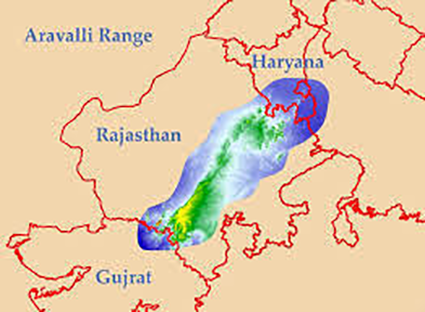Biodiversity & Environment
Appeal to Resume Mining in Aravalli Hills
- 02 Mar 2021
- 5 min read
Why in News
Recently, the Haryana government has appealed to the Supreme Court to permit it to resume mining in the Aravalli Hills on the grounds that the pandemic had grounded the State’s economy to a halt.
Key Points
- About the Aravalli Range:
- Location:
- They stretch for a distance of about 720 km from Himmatnagar in Gujarat to Delhi, spanning Haryana, Rajasthan, Gujarat, and Delhi.
- Formation:
- The Aravallis date back to millions of years when a pre-Indian subcontinent collided with the mainland Eurasian Plate.
- Age:
- Carbon dating has shown that copper and other metals mined in the ranges date back to at least the 5th century BC.
- Characteristics:
- The Aravallis of Northwestern India, one of the oldest fold mountains of the world, now form residual mountains with an elevation of 300m to 900m.
- Guru Shikhar Peak on Mount Abu is the highest peak in the Aravalli Range (1,722 m).
- It has been formed primarily of folded crust, when two convergent plates move towards each other by the process called orogenic movement.
- The Aravallis of Northwestern India, one of the oldest fold mountains of the world, now form residual mountains with an elevation of 300m to 900m.
- Extension:
- The mountains are divided into two main ranges – the Sambhar Sirohi Range and the Sambhar Khetri Range in Rajasthan, where their extension is about 560 km.
- The hidden limb of the Aravallis that extends from Delhi to Haridwar creates a divide between the drainage of rivers of the Ganga and the Indus.
- Location:
- Their Significance:
- Checks Desertification:
- The Aravallis act as a barrier between the fertile plains in the east and the sandy desert in the west.
- Historically, it is said that the Aravalli range checked the spread of the Thar desert towards the Indo-Gangetic plains, serving as a catchment of rivers and plains.
- Rich in Biodiversity:
- Provides habitat to 300 native plant species, 120 bird species and many exclusive animals like the jackal and mongoose.
- Impacts Climate:
- Aravallis have an impact upon the climate of northwest India and beyond.
- During monsoons, it provides a barrier and monsoon clouds move eastwards towards Shimla and Nainital, thus helping nurture the sub-Himalayan rivers and feeding the north Indian plains.
- In the winter months, it protects the fertile alluvial river valleys from the cold westerly winds from Central Asia.
- Recharges Groundwater:
- Aravallis also functions as a groundwater recharge zone for the regions around that absorb rainwater and revive the groundwater level.
- Checks Pollution:
- This range is considered the “lungs” for the polluted air of Delhi–National Capital Region (NCR).
- For Haryana, having the lowest forest cover at around 3.59% of the total forest cover in India, the Aravalli range is the only saving grace, providing the major portion of its forest cover (2017 Report).
- Checks Desertification:
- Threats:
- The Aravalli hills are an ecologically sensitive zone but have for years borne the brunt of quarrying and environmental degradation.
- A 2018 report by a Supreme Court-appointed Central Empowered Committee (CEC) found out that 25% of the Aravalli range has been lost due to illegal mining in Rajasthan since 1967-68.
- The consequences of the mining has been a destruction of aquifers and deforestation. Many rivers originating in the Aravalli like Banas, Luni, Sahibi and Sakhi, are now dead.
- Steps Taken:
- Mining in the Aravalli region has been banned since 2002 under the Supreme Court orders, unless expressly permitted by the Union Environment Ministry. However, mining continues illegally.
- The green wall is being planned from Porbandar to Panipat which will help in restoring degraded land through afforestation along the Aravali hill range.
- Residents along with volunteers from iamgurgaon, a citizen action group involved in the conservation of the Aravallis, were assisted by ecologists to create a self-sustaining Aravalli. This society driven model could be more effective to combat the degradation.




